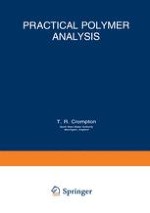1993 | Buch
Über dieses Buch
The aim of this book is to familiarize the reader with the practical aspects of polymer analysis. A wealth of practical detail, including some detailed methods is included. The book covers not only the analysis of the main types of polymers and copolymers now in use commercially, but also the analysis of minor non-polymeric components of the polymer formulation, whether they be deliberately added, such as processing additives, or whether they occur adventitiously, such as moisture and residual monomers and solvent. A broad scheme for the examination of polymers is discussed in Chapter 2. Practically all of the major newer analytical techniques and many of the older classical techniques, have been used to examine polymers and their additive systems. As so many different polymers are now used commercially it is also advisable when attempting to identify a polymer to classify it by first separating it into pure polymeric and gross non polymeric fractions (Chapter Z) and then carrying out at least a qualitative elemental analysis and possible a quantitative analysis (Chapters 3 and 4) and then in some cases, depending on the elements found, to carry out functional group analysis (Chapters 6 and 9).
Anzeige
